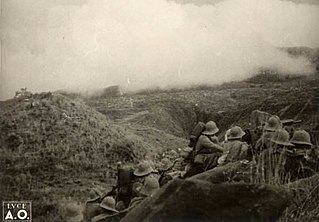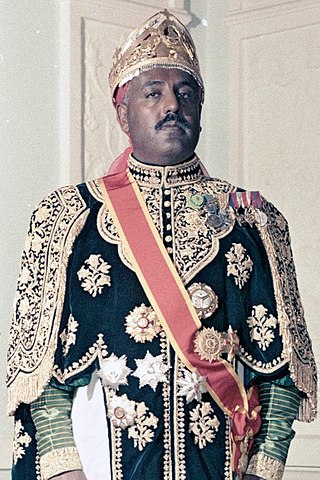Related Research Articles

The Second Italo-Ethiopian War, also referred to as the Second Italo-Abyssinian War, was a war of aggression which was fought between Italy and Ethiopia from October 1935 to February 1937. In Ethiopia it is often referred to simply as the Italian Invasion, and in Italy as the Ethiopian War. It is seen as an example of the expansionist policy that characterized the Axis powers and the ineffectiveness of the League of Nations before the outbreak of the Second World War.
The Battle of Maychew was the last major battle fought on the northern front during the Second Italo-Abyssinian War. The battle consisted of a failed counterattack by the Ethiopian forces under Emperor Haile Selassie making frontal assaults against prepared Italian defensive positions under the command of Marshal Pietro Badoglio. The battle was fought near Maychew, Ethiopia, in the modern region of Tigray.
The Battle of Gur Amba was a battle fought on 27 November 1852 between the forces of the Ethiopian regent, Ras Ali II, and the rebel forces of Kassa Hailu. Kassa was victorious, and Goshu Zewde of Mota, Gojjam, the commander of the regent's forces, was killed. This was the first of a series of four victories which led to Kassa becoming Emperor Tewodros II of Ethiopia.
The Battle of Takusa was a short military engagement fought on 12 April 1853 between the forces of Kassa Hailu, future Emperor of Ethiopia, and an alliance of several rival warlords. The forces of Kassa's enemies were led by Dejazmach Birru Aligaz and Samuel Birhanu, who was reinforced by troops sent to him by Wube Haile Maryam under the command of his son, Gwangul Wube.
The Battle of Amba Jebelli was fought in Ethiopia in 1854 between the forces of Kassa Hailu, and the forces of Birru Goshu of Gojjam. Kassa was victorious, Birru Goshu was captured and spent the next 14 years in chains.
The Battle of Ayshal was fought on June 29, 1853, between the forces of Kassa Hailu and the forces of Ras Ali II, in Ayshal, in eastern Gojjam. Kassa's forces won the battle.

The Zemene Mesafint was a period in Ethiopian history between the mid-18th and mid-19th centuries when the country was ruled by a class of Oromo elite noblemen who replaced the Tigrayan and Amhara nobility in their courts, making the emperor merely a figurehead. For the most part, the regional lords were tightly related by marriage and constituted a stable ruling elite that prevailed until the mid 20th century. In short, during the Zemene Mesafint, the Emperors from the Solomonic dynasty were reduced to little more than figureheads confined to the capital city of Gondar.

Ethiopian forces in the Second Italo-Abyssinian War besides the Central Army were mobilized from various provinces under their local leader. According to 1935 Italian intelligence estimates of the Ethiopian provinces and their forces on the eve of hostilities, the Ethiopians had an army of 350,000 men. Strengths where known are noted followed by their leader. Modernized forces in Bold.

The Second Battle of Tembien was a battle fought on the northern front of the Second Italo-Ethiopian War. This battle consisted of attacks by Italian forces under Marshal Pietro Badoglio on Ethiopian forces under Ras Kassa Haile Darge and Ras Seyoum Mangasha. This battle, which resulted in a decisive defeat of Ethiopian forces, was primarily fought in the area around the Tembien Province. The battle is notable for the large-scale use of mustard gas by the Italians.

RasKassa Hailu KS, GCVO, GBE, was a Shewan Amhara nobleman, the son of Dejazmach Haile Wolde Kiros of Lasta, the ruling heir of Lasta's throne and younger brother of Emperor Tekle Giyorgis II, and Tisseme Darge, the daughter of Ras Darge Sahle Selassie, brother of Menelik II's father.
The First Battle of Tembien was a battle fought on the northern front of what was known as the Second Italo-Ethiopian War. This battle consisted of attacks and counterattacks by Italian forces under Marshal Pietro Badoglio and Ethiopian forces under Ras Kassa Haile Darge. This battle was primarily fought around Worsege Pass in what was then the Tembien Province of Ethiopia.

The Battle of Amba Aradam was a battle fought on the northern front of what was known as the Second Italo-Abyssinian War. This battle consisted of attacks and counter-attacks by Italian forces under Marshal of Italy Pietro Badoglio and Ethiopian forces under Ras Mulugeta Yeggazu. This battle was primarily fought in the area around Amba Aradam which included most of Enderta Province.

The Battle of Shire was a battle fought on the northern front of what was known as the Second Italo-Abyssinian War. This battle consisted of attacks and counterattacks by Italian forces under Marshal of Italy Pietro Badoglio and Ethiopian forces under Ras Imru Haile Selassie. This battle was primarily fought in the Shire area of Ethiopia.
The Battle of Anchem was a battle fought between two factions of the Royal family in the Ethiopian Empire. The battle was fought to determine who would rule the empire, Empress Zewditu or King (Negus) Tafari Makonnen.
Wondosson Kassa, also known as Wond Wossen Kassa, was a member of the royalty of the Ethiopian Empire, an army commander, and a patriot.
Aberra Kassa was an army commander and a member of the Royal family of the Ethiopian Empire.
Asfawossen Kassa was an army commander and a member of the royal family of the Ethiopian Empire.

LeulRasAserate KassaGCVO was a Viceroy of Eritrea and a member of the nobility of the Ethiopian Empire. He was the fourth son of Ras Kassa Haile Darge, and his wife Princess (Le'ilt) Tsige Mariam Beshah. Prince Aserate Kassa was educated at Monkton Combe School in the United Kingdom between 1937 and 1938. He was married to (Le'ilt) Zuriashwork Gebre-Igziabiher, daughter of Jantirar Gebre-Igziabiher, and granddaughter of Empress Menen Asfaw, consort of Emperor Haile Selassie I. Prince Aserate Kassa was the head of the Selalle sub-branch of the Shewan branch of Ethiopia's Imperial Solomonic dynasty.

The Arbegnoch were Ethiopian anti-fascist World War II resistance fighters in Italian East Africa from 1936 until 1941 who fought against Fascist Italy's occupation of the Ethiopian Empire.
The Battle of Adwa, also called the Battle of the Assem, Asem, Asam, or Assam river, was a battle fought in 1871 between the forces of Kassa Mercha of Tigray and Emperor Tekle Giyorgis II. It resulted in victory for Kassa, allowing him to eventually become crowned as Emperor of Ethiopia. This battle has been noted by some as one of the first 'truly modern' battles in Ethiopian history, given that the tactics used by Kassa of Tigray revolved around the use of gunpowder weaponry.
References
- ↑ Thomas P. Ofcansky; David H. Shinn (29 March 2004). Historical Dictionary of Ethiopia. Scarecrow Press. pp. 376–. ISBN 978-0-8108-6566-2.